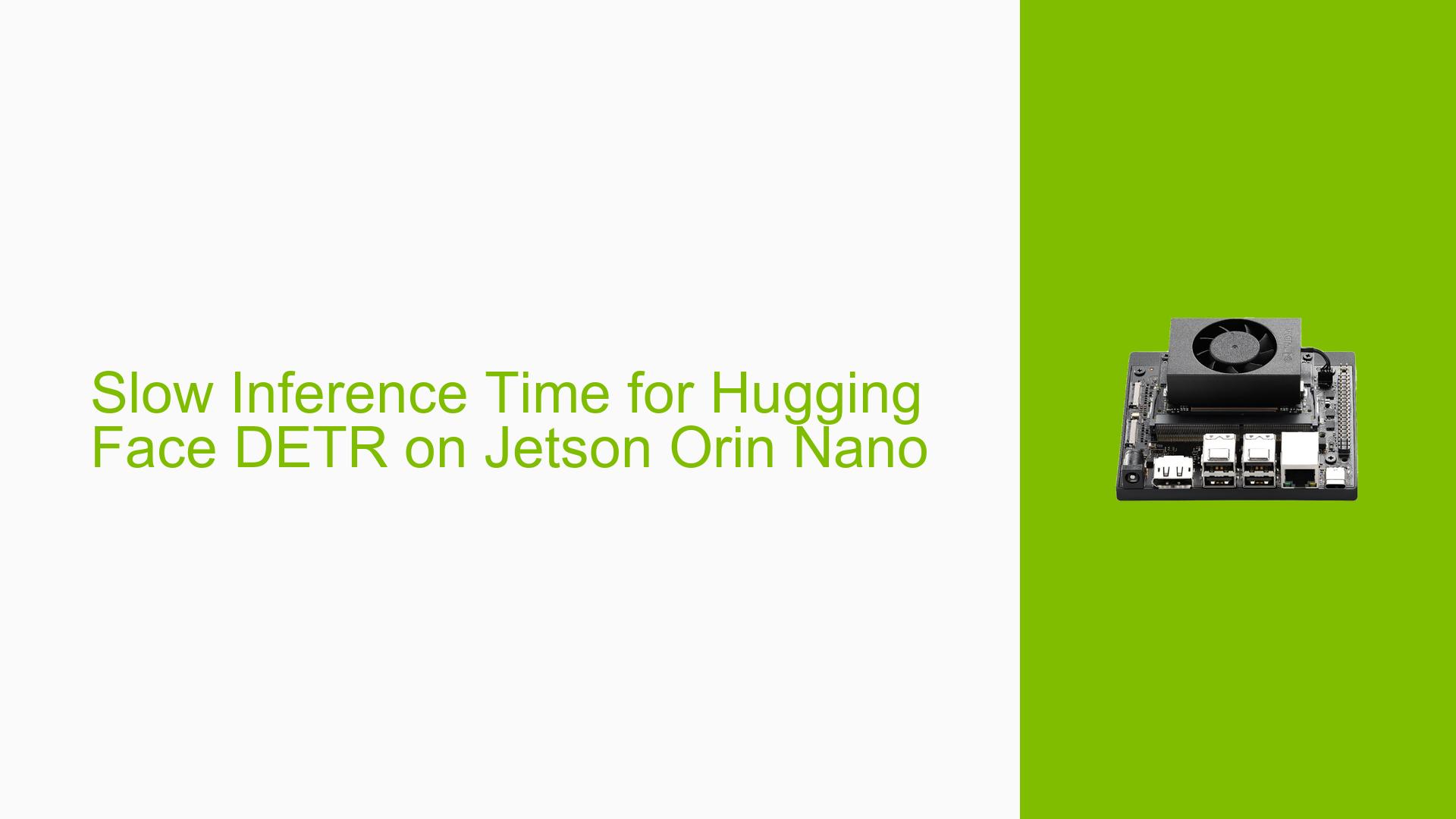Slow Inference Time for Hugging Face DETR on Jetson Orin Nano
Issue Overview
Users are experiencing unexpectedly slow inference times when running the Hugging Face DETR (DEtection TRansformer) object detection algorithm on the Nvidia Jetson Orin Nano (8GB, 15W) developer board. The issue is characterized by the following observations:
- Inference time on the Jetson Orin Nano is approximately 4 seconds for an 800×800 pixel image.
- There is little difference in performance between using CUDA (.to(‘cuda’)) and CPU (.to(‘cpu’)) on the Jetson.
- The same model configuration runs in about 1 second on an iMac with a 3.3 GHz 6-Core Intel Core i5 CPU (no GPU).
- GPU utilization on the Jetson is 0% when using CPU and only slightly higher when using CUDA.
- The model is configured with config.num_queries = 500.
- Testing is performed using the ‘dustynv/transformers:git-r35.3.1’ Docker container.
Possible Causes
-
Data Access Bottleneck: The low GPU utilization suggests that the GPU might be waiting for data, indicating a potential bottleneck in data transfer or preprocessing.
-
Inefficient Model Initialization: The model may be reinitializing for each inference call, leading to unnecessary overhead.
-
Suboptimal PyTorch Configuration: The PyTorch setup on the Jetson might not be optimized for the specific hardware, leading to underutilization of the GPU.
-
Memory Constraints: The 8GB memory of the Jetson Orin Nano might be insufficient for efficient processing of the model, causing slowdowns.
-
Docker Container Overhead: The use of a Docker container might introduce some performance overhead, although this is likely minimal.
-
Power Management Settings: The 15W power setting of the Jetson Orin Nano might be limiting its performance capabilities.
Troubleshooting Steps, Solutions & Fixes
-
Loop Inference Calls:
- Implement a loop around the inference call to reduce the impact of initialization overhead and improve GPU utilization.
- Example implementation:
num_iterations = 100 total_time = 0 for _ in range(num_iterations): start_time = time.time() outputs = model(inputs) total_time += time.time() - start_time average_time = total_time / num_iterations print(f"Average inference time: {average_time} seconds")
This solution reduced the inference time to 0.25 seconds and increased GPU utilization.
-
Optimize Data Loading:
- Use PyTorch’s DataLoader with num_workers set appropriately for the Jetson’s CPU.
- Implement prefetching to ensure data is ready when the GPU needs it.
- Example:
dataloader = DataLoader(dataset, batch_size=1, num_workers=4, pin_memory=True)
-
Use TensorRT Optimization:
- Convert the PyTorch model to TensorRT for optimized inference on Jetson hardware.
- Follow NVIDIA’s documentation for TensorRT integration with PyTorch.
-
Profile the Code:
- Use NVIDIA’s Nsight Systems or PyTorch’s built-in profiler to identify bottlenecks in the inference pipeline.
- Example using PyTorch profiler:
with torch.profiler.profile(activities=[torch.profiler.ProfilerActivity.CPU, torch.profiler.ProfilerActivity.CUDA]) as prof: model(inputs) print(prof.key_averages().table(sort_by="cuda_time_total", row_limit=10))
-
Optimize Model Parameters:
- Experiment with different values for config.num_queries to find an optimal balance between accuracy and speed.
- Consider using a smaller or quantized version of the DETR model if full accuracy is not required.
-
Check Jetson Power Mode:
- Ensure the Jetson is running in maximum performance mode:
sudo nvpmodel -m 0 sudo jetson_clocks
- Ensure the Jetson is running in maximum performance mode:
-
Update Software Stack:
- Ensure you’re using the latest JetPack version compatible with your model.
- Update PyTorch, torchvision, and other relevant libraries to their latest versions compatible with the Jetson platform.
-
Optimize Input Processing:
- Preprocess images on the CPU and transfer them to GPU memory efficiently:
inputs = inputs.to('cuda', non_blocking=True)
- Preprocess images on the CPU and transfer them to GPU memory efficiently:
-
Batch Processing:
- If processing multiple images, use batching to improve throughput:
batch_size = 4 inputs = torch.stack([input_tensor] * batch_size) outputs = model(inputs)
- If processing multiple images, use batching to improve throughput:
-
Monitor System Resources:
- Use
tegrastatsto monitor CPU, GPU, and memory usage during inference:tegrastats --interval 1000 - This can help identify if there are any resource constraints affecting performance.
- Use
By implementing these solutions, particularly looping the inference calls, users have reported significant improvements in inference time and GPU utilization on the Jetson Orin Nano. Continue to monitor performance and adjust settings as needed for optimal results.
